本文由 Fletcher Studio 授权mooool发表,欢迎转发,禁止以mooool编辑版本转载。
Thanks Fletcher Studio for authorizing the publication of the project on mooool, Text description provided by Fletcher Studio.
Fletcher Studio:该公园有着悠久而丰富的历史,一直服务于各种不同的人群,这些年现在它转变为移民、难民、码头工人、艺术家和年轻的专业人士服务。South Park 始建于1855年,是一个风景如画的散步公园,位于一个高档住宅区的中心。在19世纪末首次对公众开放,为来到这里的码头和仓库工作的移民提供了喘息的生活空间。在1906年地震和火灾之后的几年里,这个公园作为一个难民营,为648人提供了临时住所。随着20世纪初街区的重建,码头工人在等待工会大厅的电话时在这个公园里燃起了篝火取暖。到了20世纪末,公园发展迅速,为了满足快速变化的人口的需求,公园进行了自我改造:先是家庭单位,然后是老人、残疾人和无家可归者搬进了住宅,最后是互联网热潮中的年轻专业人士。
Fletcher Studio:The site has a long and rich history serving a variety of diverse populations. Its transformation over the years has served immigrants, refugees, longshoremen, artists, and young professionals. South Park was originally constructed in 1855 as an English picturesque strolling park at the center of an exclusive residential community. At the end of the 19th century it was given over the public and provided respite for immigrants who had moved to the area to work in the docks and warehouses. In the years following the 1906 Earthquake and Fire the park served as a refugee camp, providing temporary housing for 648 people. As the neighborhood rebuilt, throughout the early 20th century, bonfires burned in the park as longshoremen kept warm, waiting for calls from the union hall. Towards the end of the 20th century, the park evolved quickly, reinventing itself to meet the needs of a quickly changing population: first families, then elderly and disabled homeless moving into residential hotels, and finally young professionals in the dot-com boom.

多年的改造导致南方公园年久失修。2011年,南方公园改善协会(South Park Improvement Association)委托了一家景观设计公司为该公园进行设计。设计团队与邻居及社区领袖密切合作,协助举办了12次以上的社区外展会议,并制定了公园总体规划和景观设计。这些设计在对灵活公共空间的需求和缓解主要基础设施和功能问题之间进行了协调,包括排水不良和缺乏ADA可达性。
Over the years, ad-hoc improvements had led South Park into disrepair. In 2011, The South Park Improvement Association appointed a landscape architecture firm to develop a design for the park. Working closely with neighbors and community leaders, the design team helped to facilitate more than 12 community outreach meetings and develop a park masterplan and landscape design. These designs negotiate between the need for flexible public spaces and alleviating major infrastructural and functional issues including poor drainage and lack of ADA accessibility.
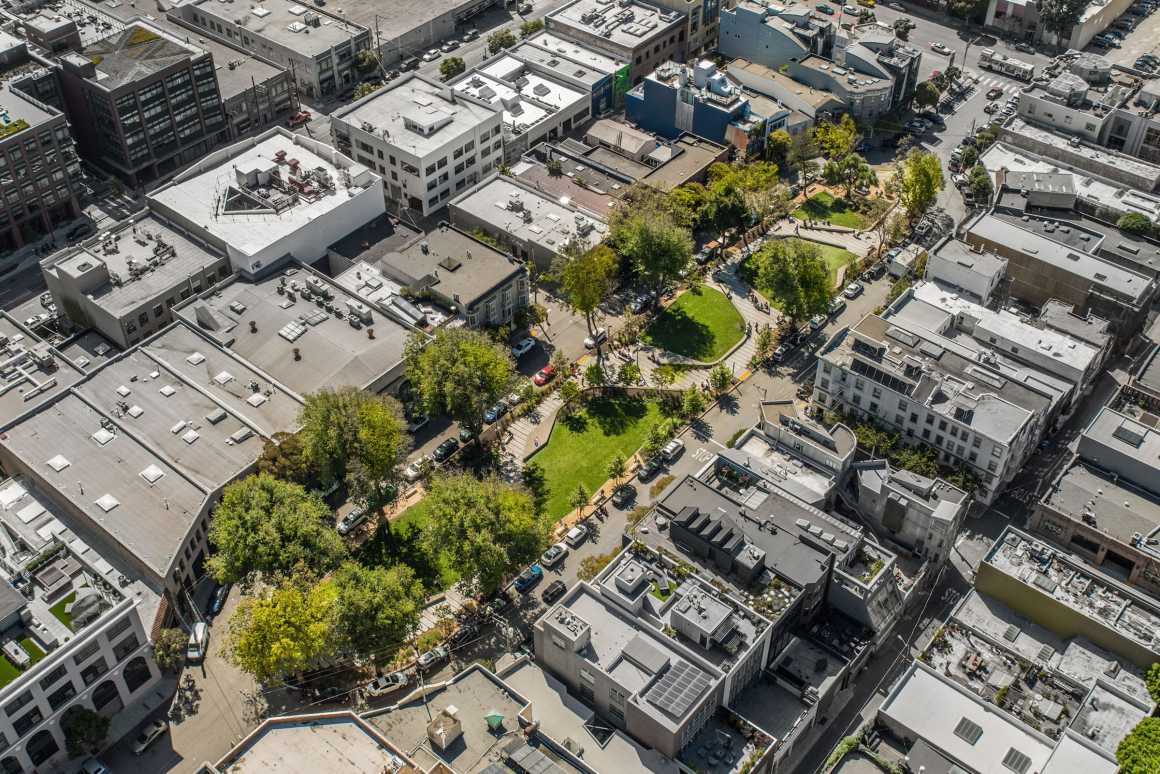
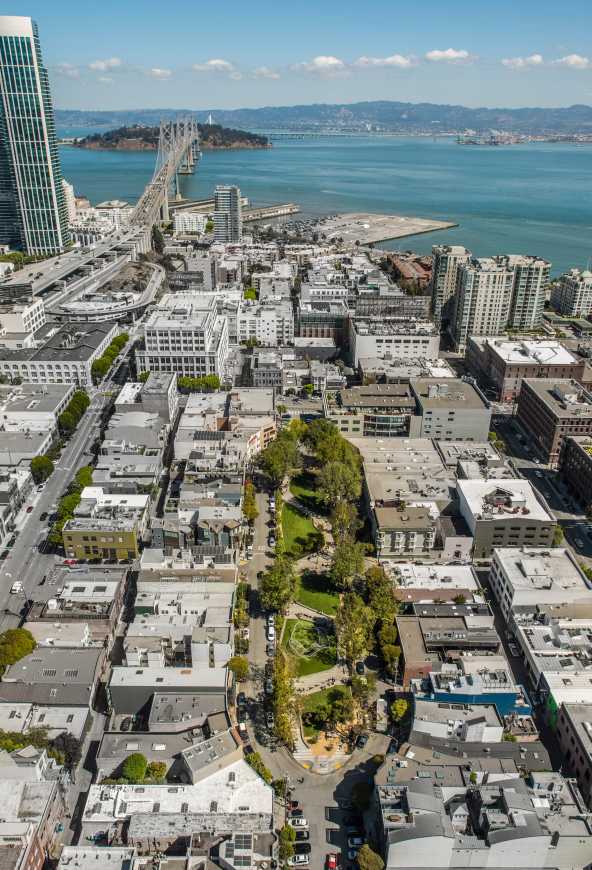
公园的新设计是对景观的当代诠释,引导游客沿着精心设计的蜿蜒路径,展现出各种无障碍设施和灵活的空间。正式设计决策的主要决定因素是由现有树木的层次结构、要保留的结构、流通模式、接入点、社交节点和预期用途来驱动的。通过将这些点与单一路径连接起来,形成了一条连贯的连接了各种舒适空间的线性长廊,沿着公园在色彩丰富、耐旱的植物间蜿蜒前行,也可以横向穿越。通过路径的增厚或变薄,沿着路径排列的程序元素在关键接合处形成不同尺度的广场。
The new design of the park may be described as a contemporary interpretation of the picturesque, guiding visitors along a carefully choreographed, meandering pathway while revealing a variety of accessible amenities and flexible spaces. The primary determining factors of the formal design decisions were driven by a hierarchy of existing trees, structures to remain, circulation patterns, access points, social nodes and intended use. By linking these points with a single path, the design forms a consistent linear promenade connecting a variety of amenity spaces while meandering amongst colorful and drought-tolerant plants along the length of the park and allowing for lateral crossing. The programmatic elements arrayed along the pathway are anchored by varying scales of plazas, formed at key junctures, through the thickening and thinning of the path.
▼总平面图 Master plan

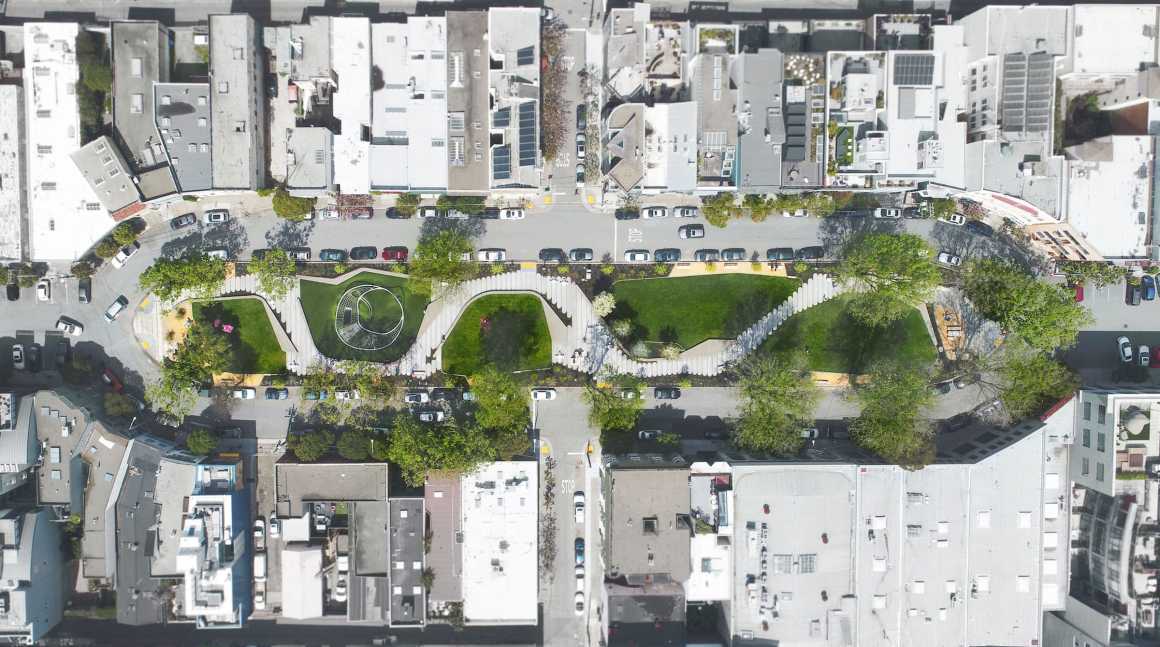
景观设计共采用了四种紧密结合的材料系统:可扩展的模块化铺装系统、大型的倾斜草地、植被渗透盆地和种植区的低挡土墙。由此产生的设计包括一系列穿过公园的长墙,长墙可用于限定空间、保持坡度,并提供座位和保护免受邻近街道的影响。该路径的构造系统由简单易于修改的组件组合组成,这些组件可以灵活适用于不同的空间、项目和地形。道路系统则由现场浇注的混凝土铺路材料组成,看起来像具有圆形边缘和沿着公园南北轴线排列的“滑块”带的单个“平板”材料。这两个元素的组合满足了背景内外部空间需求的路径宽度的相干调制,以及场地特定条件的路径边缘的细粒度调整。我们还更新并改进了基础设施,包括最先进的灌溉系统、生物渗透洼地、流经种植器的水流、地下渗透井和灯泡,以改善行人安全和交通。
The design strategy utilized four tightly bound material systems: an expandable, modular paving system; large sloping meadows; vegetated infiltration basins; and low retaining walls that mediate between paving and planted areas. The resulting design includes a series of long walls that flow through the park, to define spaces, hold grade, and provide seating and protection from the adjacent streets. The tectonic system for the path consists of a simply constructed combination of easily modified components that allow for diverse spatial, programmatic, and topographic solutions. The path system is comprised of site-cast concrete paving constructed to look like individual “tablet” pavers with rounded edges and “slider” bands that are arrayed along the north/south axis throughout the park. The combination of these two elements allows for a coherent modulation in the width of the path responding to contextual/external spatial desires, and fine-grain adjustment of the path edge that responds to site-specific conditions. The design also updated and made major infrastructural improvements including a state of the art irrigation system, bio-infiltration swales, flow through planters, subsurface infiltration wells and bulb-outs for improved pedestrian safety and traffic calming.
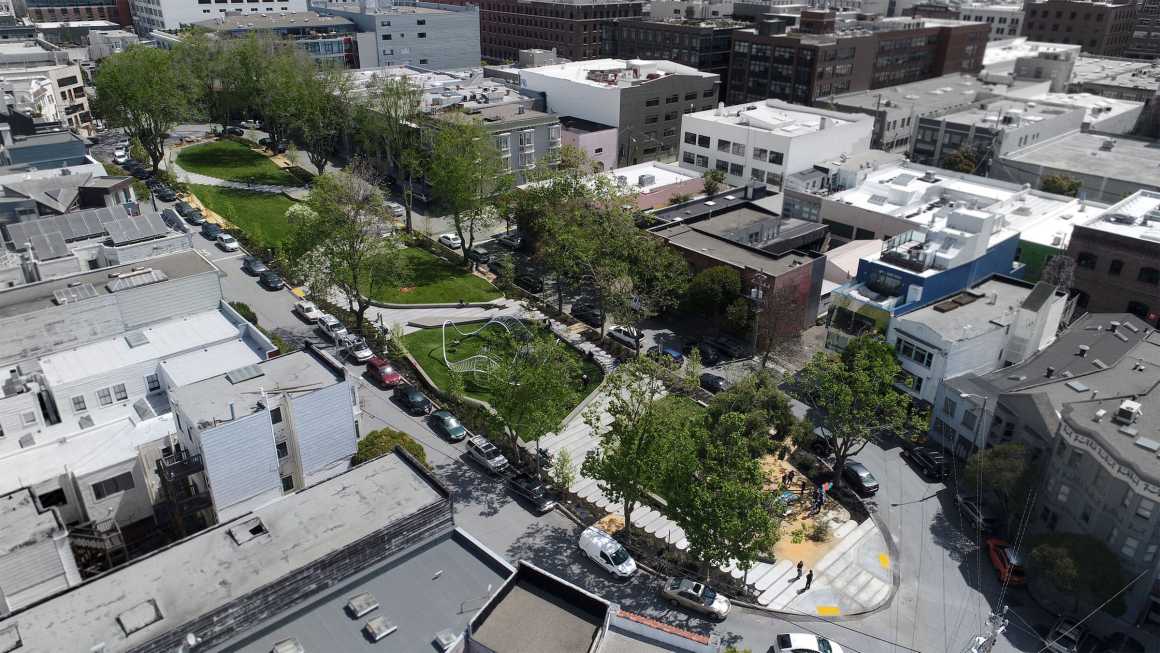
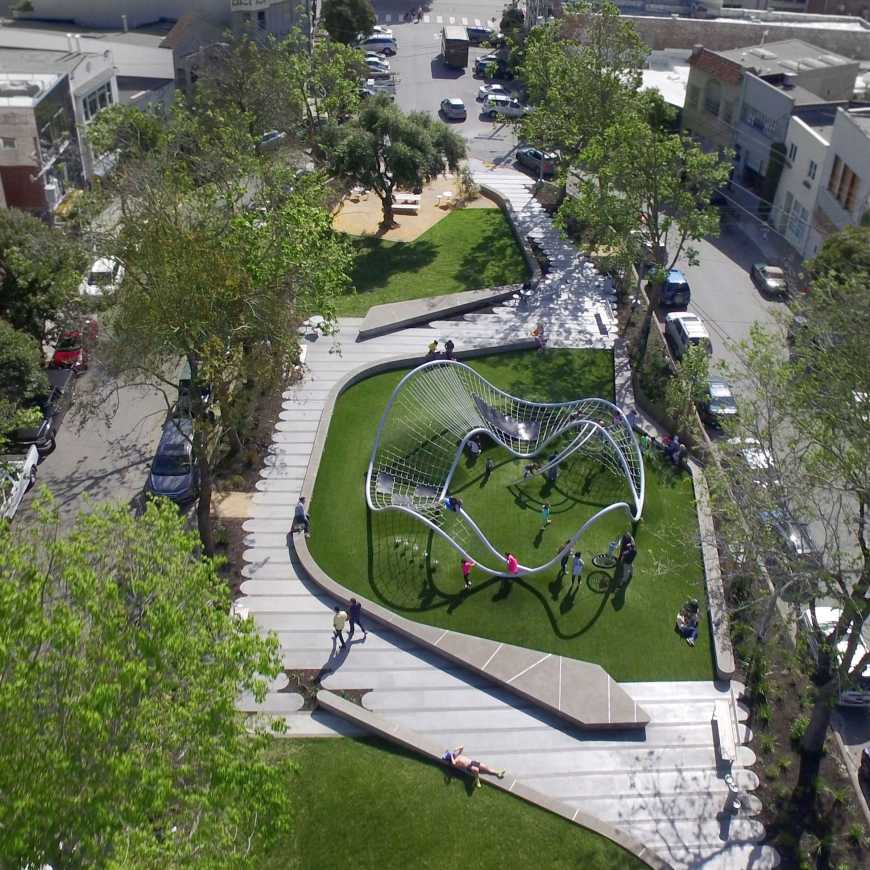
每个元素节点包含一个“通用”游戏区。定制设计的游戏结构形式灵感来源于两个相连圆圈的简单目标和海洋软体动物裸鳃海蛞蝓美丽的流动性。圆形的护堤从游戏区逐渐升起,它在向地平面倾斜时,与游戏结构刚好相接。土墩也有多种使用功能,既可提供非正式的游戏空间,又可沿着结构的边缘形成一个进入游戏区的入口。游戏结构使用参数化软件设计模型定制而成,它可以快速生成该结构的多个版本,还会根据周边和内部管道形式的操作自动分配网、构件和游戏元素。
One programmatic element included a ‘universal’ play area. The custom designed play structure form came from the simple goal of two connecting circles and the beautiful fluidity of Nudibranch, a sea mollusk. Rounded berms rise from the play surface, to meet the structure as it dips down towards the groundplane. The mounds have multiple functions, providing informal play space while providing points of access to play elements and framing an accessible area along the edge of the structure. Parametric software was again used to generate a responsive model for the custom play structure, this model allowed us to quickly generate multiple versions of the structure. It also would automatically distribute netting, fittings, and play elements, responding to the manipulation of the perimeter and interior tube forms.
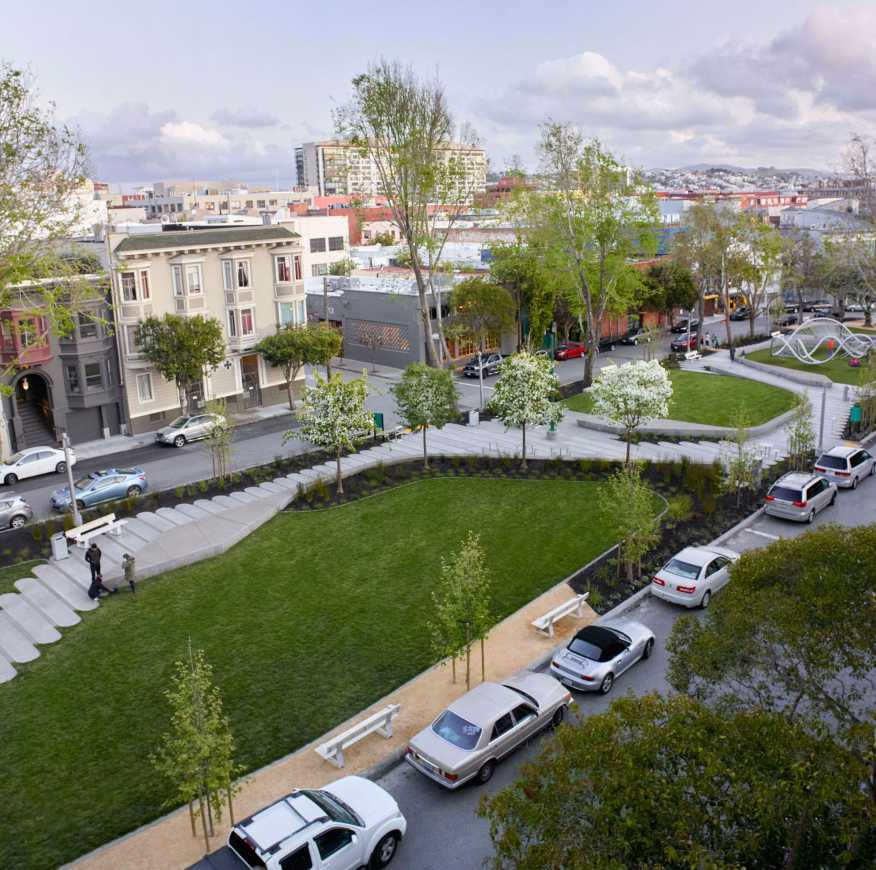
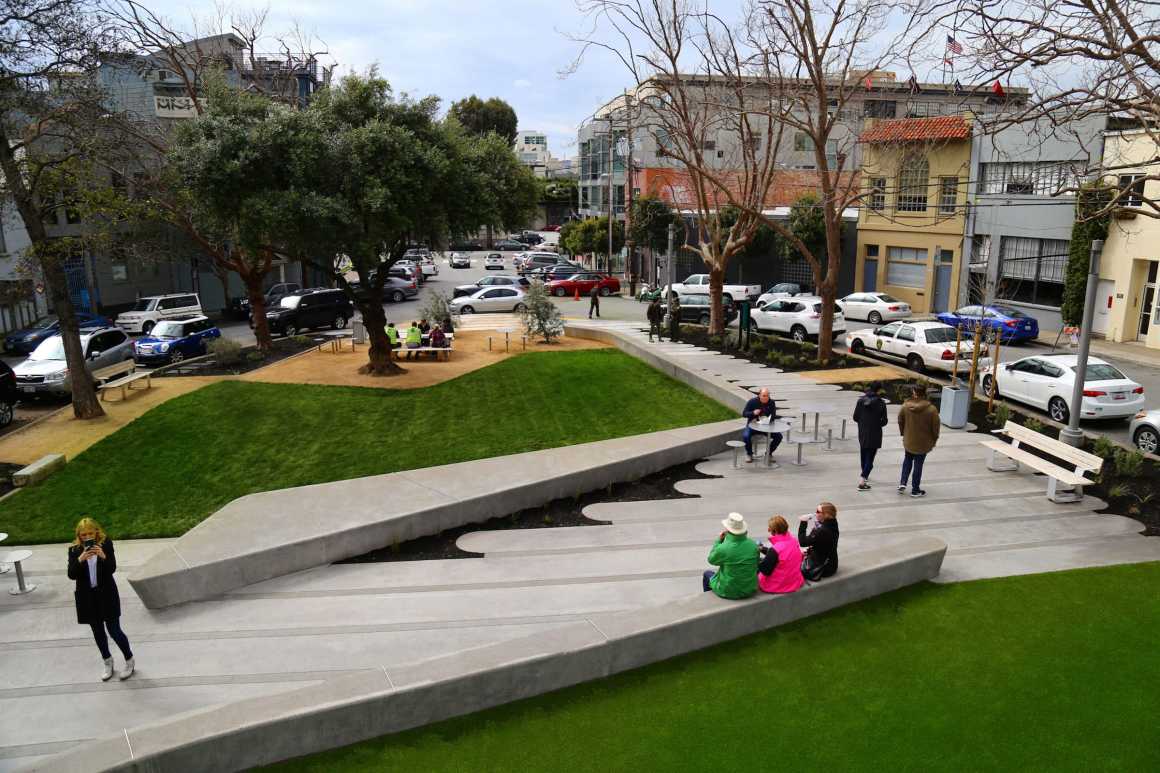
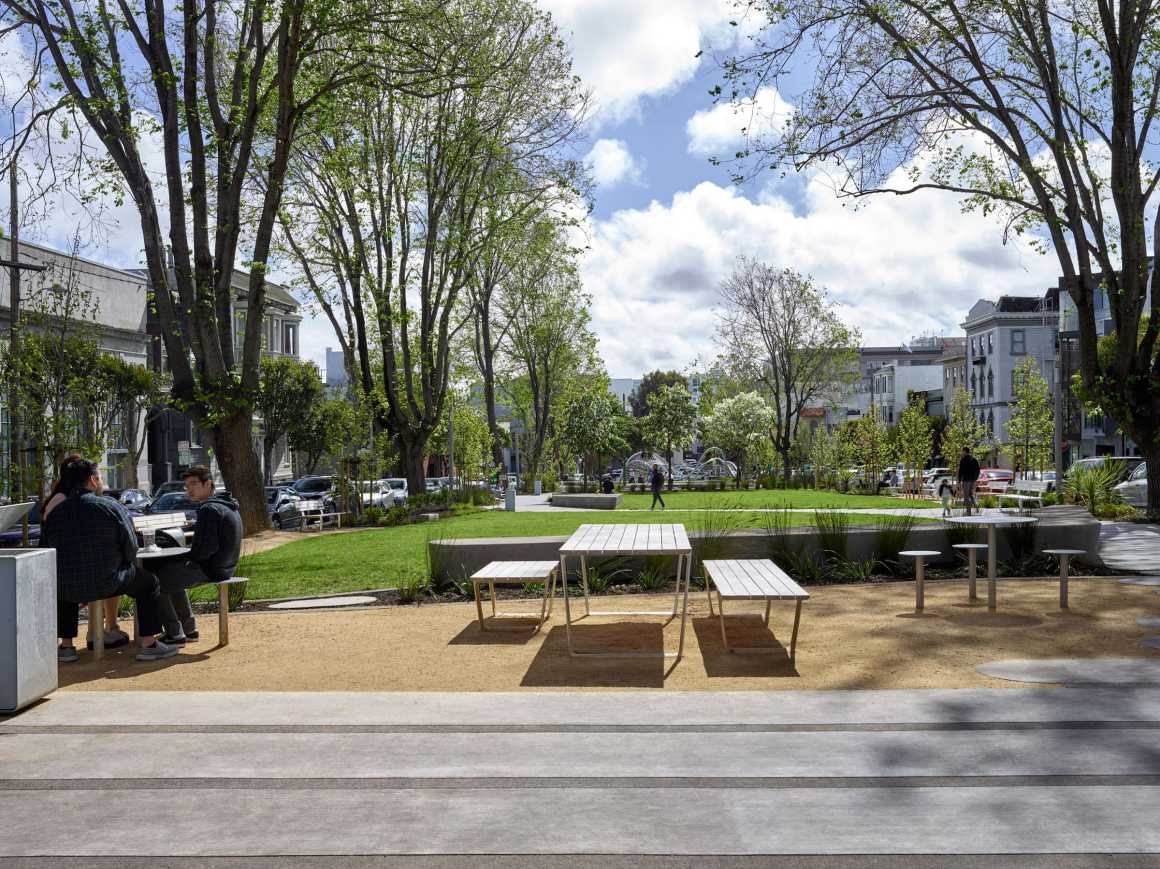
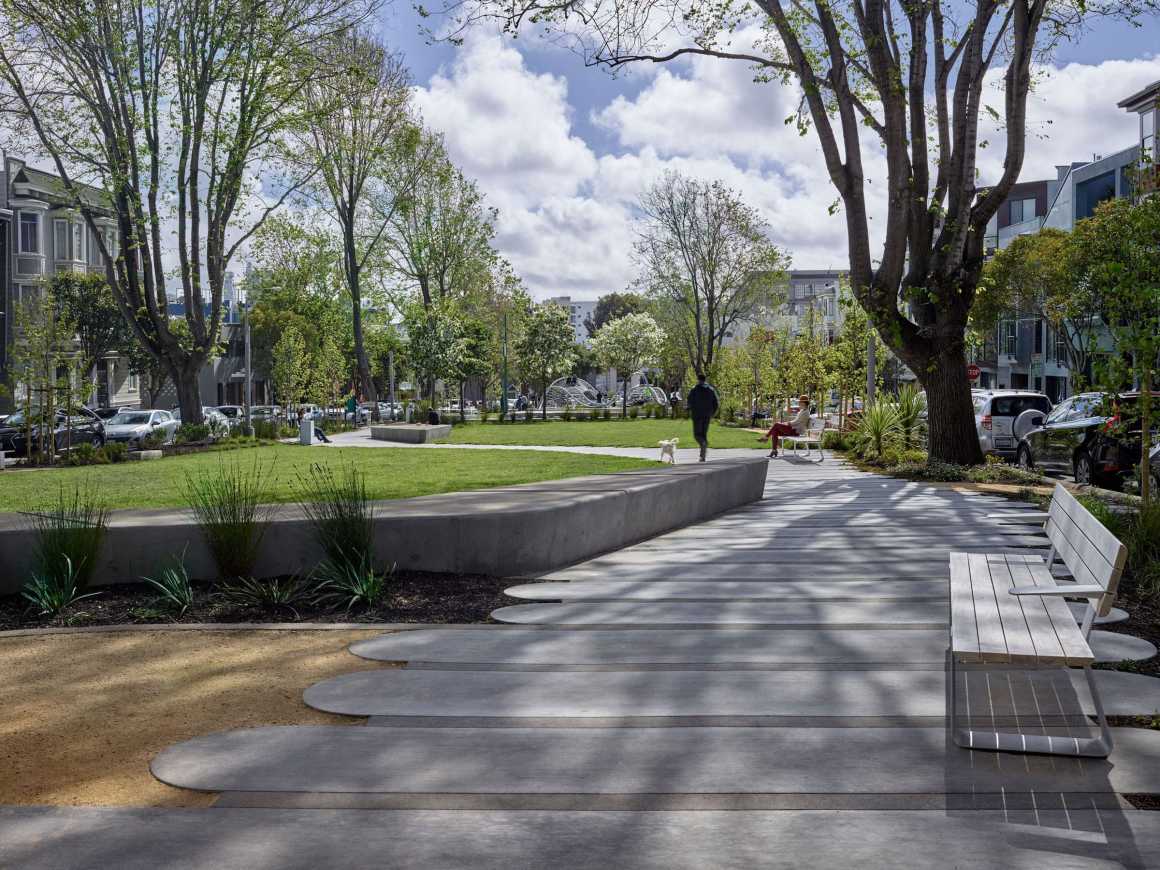
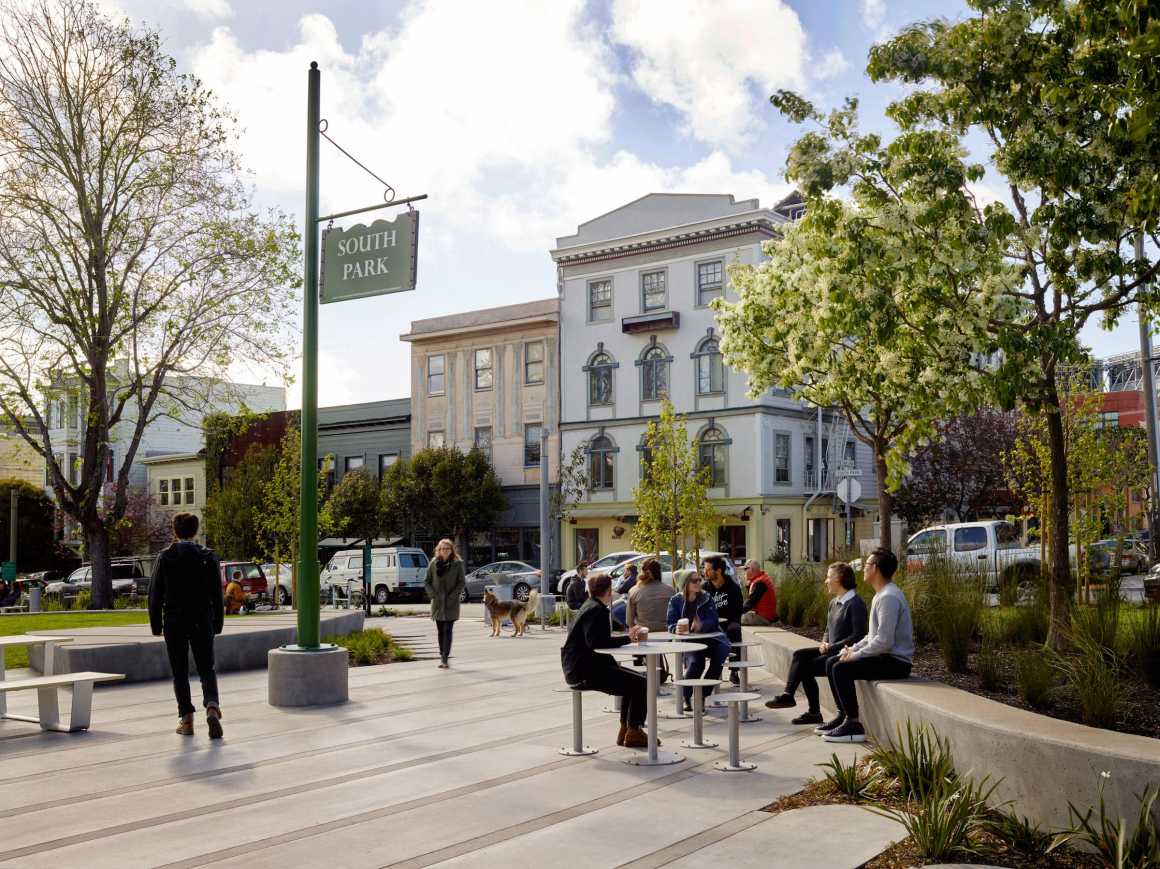
场地的高差变化超过22英尺,为了达到和接近公共空间的严格公差,铺设的准确高程点被输入grasshopper生成topo网格。可以根据主模型检查地形的修改,以确定需要的误差或调整。排水仰拱点之间可以相互连接,将得到的矢量转换成管道,这样就可以以模型形式对排水系统进行评估,从而避免潜在的冲突,并为挖沟弃土进行体积计算。
With over 22 feet of grade change on the site, and tight tolerances to achieve and accessible public space, accurate elevation points of the paving were input into grasshopper to generate a topo mesh. Modifications to the topography could be checked against the master model for errors or adjustments needed. Drainage inverts points could be connected to each other, with the resulting vectors converted into tubes so that the drainage system could be evaluated in model form helping to avoid potential conflicts as well as generate volume calculations for trenching spoils.
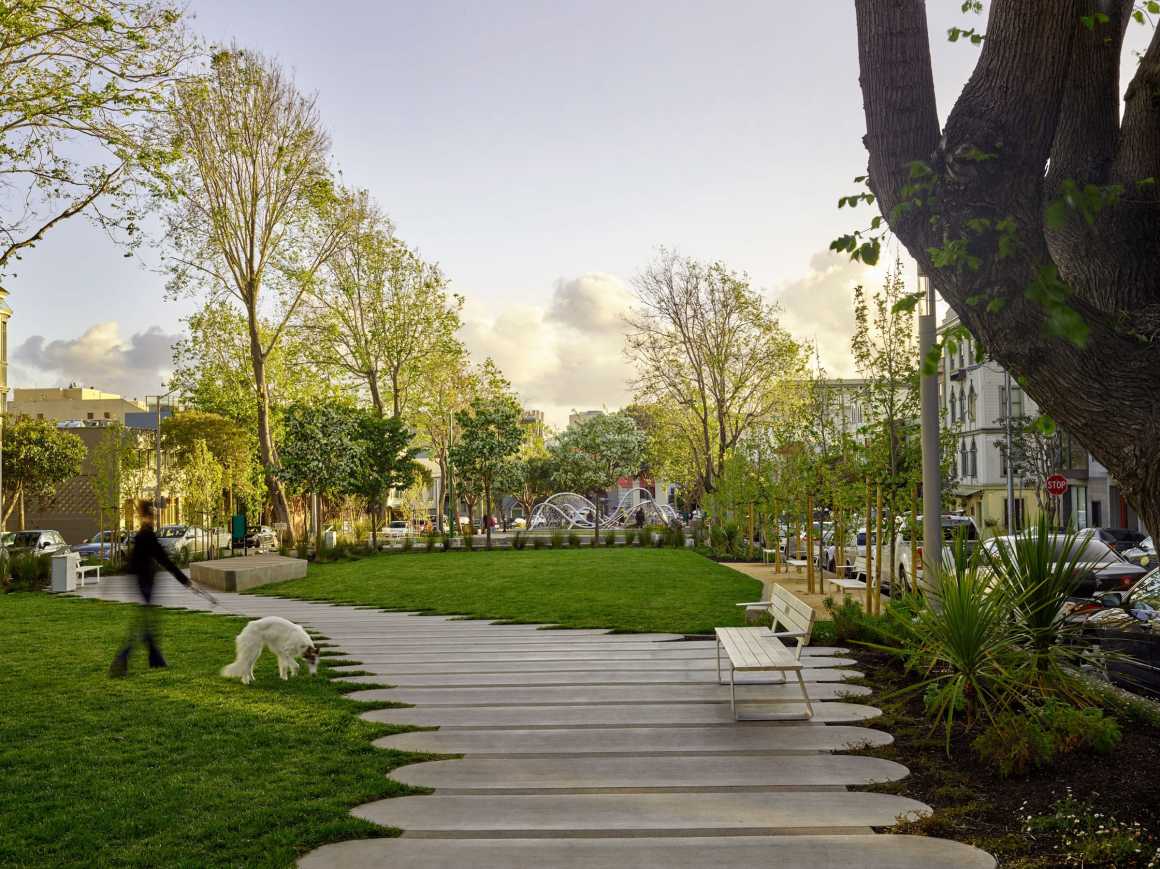

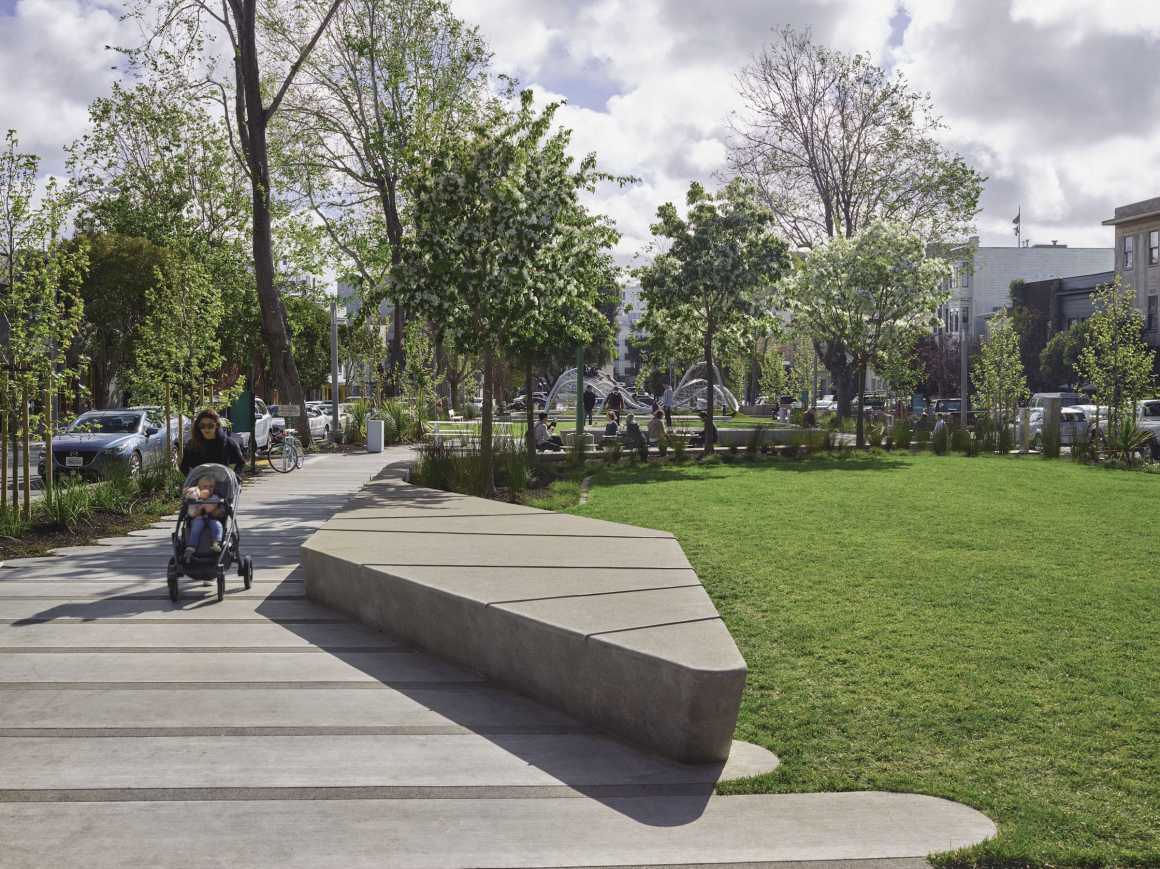
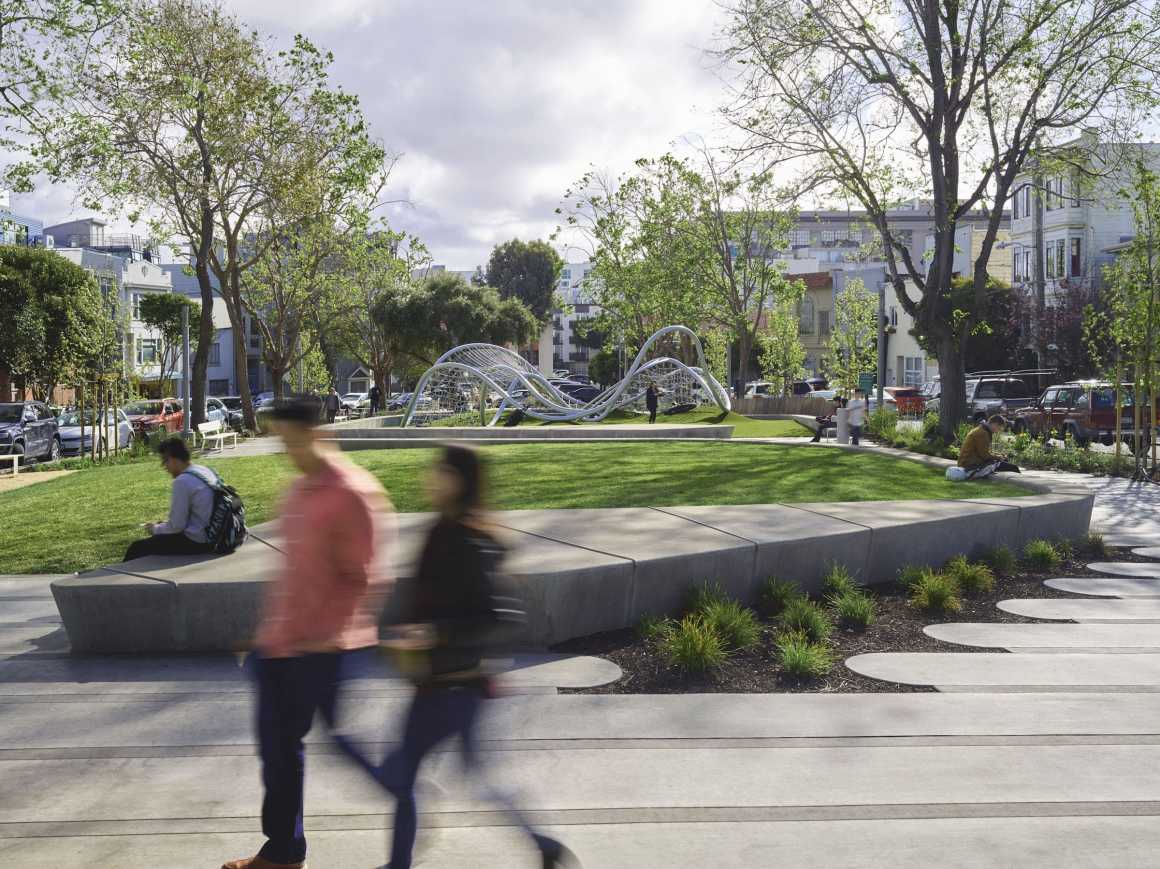
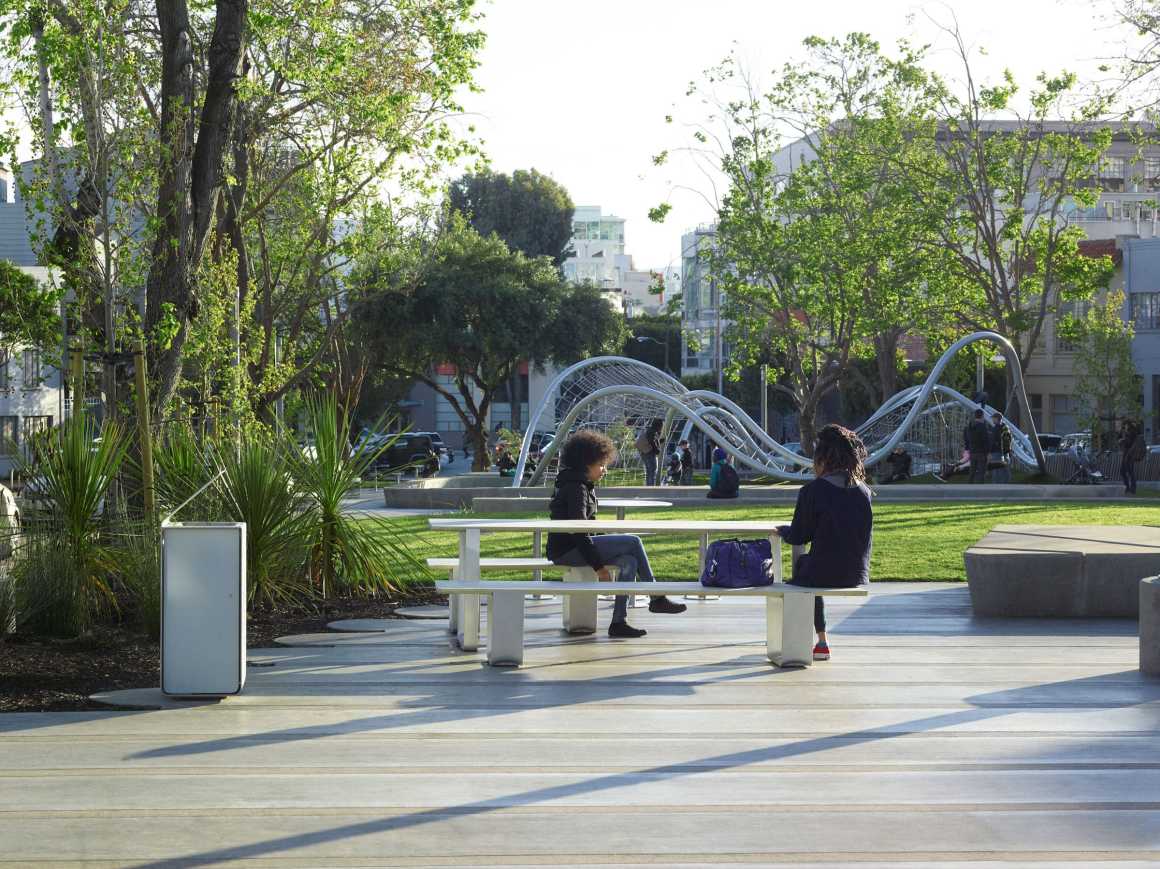
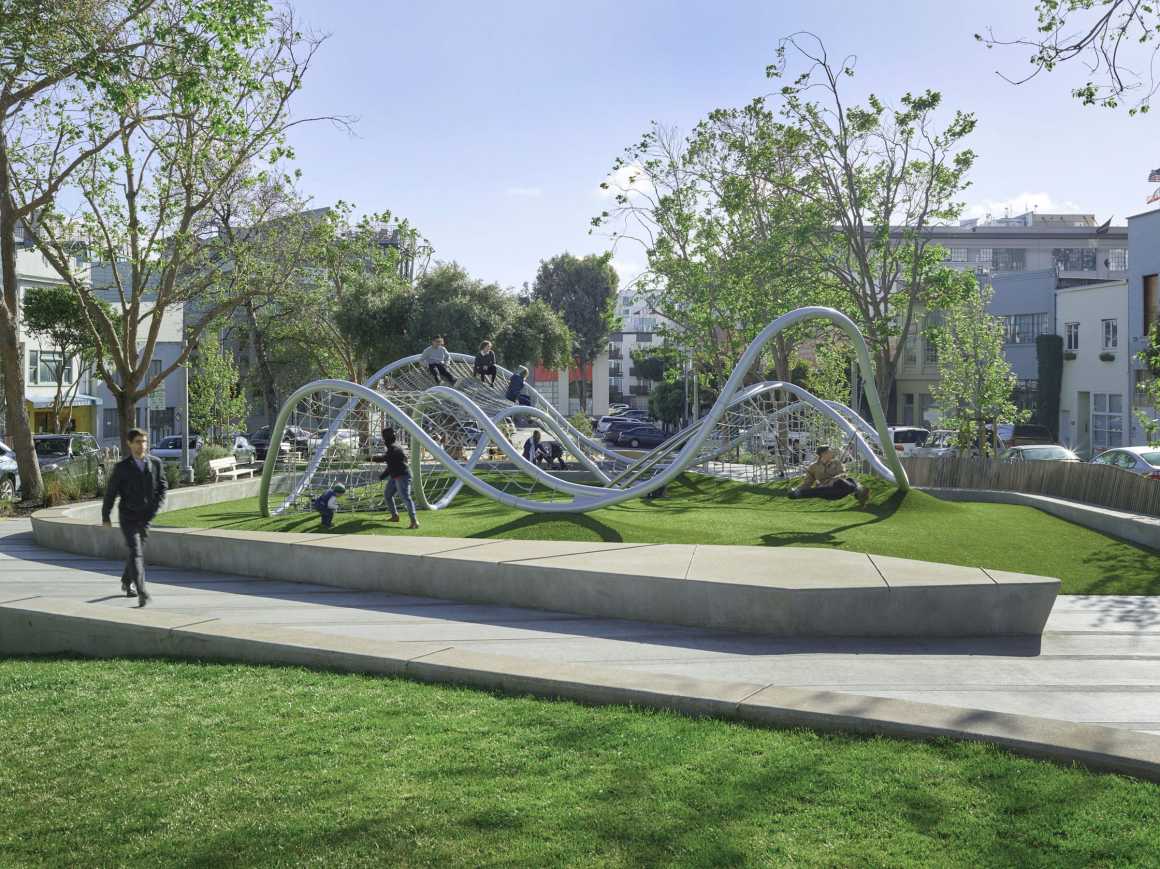
公园里的生态可持续的设计包括种植了耐旱植物的高效生物渗透花园,以及利用现场收集的雨水的灌溉系统。并且公园也具有社会可持续性,满足了经济多样化人口的需求,为所有年龄段的人提供无障碍的游戏空间,并为公众提供多样的使用空间。公园没有设置围栏,可向所有人开放。混凝土座椅和挡土墙为日常生活的剧院提供了非正式的座位和舞台。通过将历史分析与参数化设计和当代美学相结合,南方公园成功地成为了一个生态和社会可持续公园,为使用、连接和愉悦创造了舞台,同时创造了一个既有吸引力又在不断发展的空间。
Drought tolerant plantings, performative bioinfiltration gardens, and an irrigation system that utilizes rainwater collected on-site work together to create an ecologically sustainable design. However, the park is also socially sustainable, meeting the needs of an economically diverse population, providing accessible play space for all ages, and offering diverse spaces for public use. A lack of fences opens the park to all, while short concrete seat and retaining walls offer informal seating and stages for the theater of daily life. By combining historical analysis with parametric design and a contemporary aesthetic, South Park succeeds as an ecologically and socially sustainable park, setting the stage for use, connection, and delight while creating a space that is both magnetic and evolving.
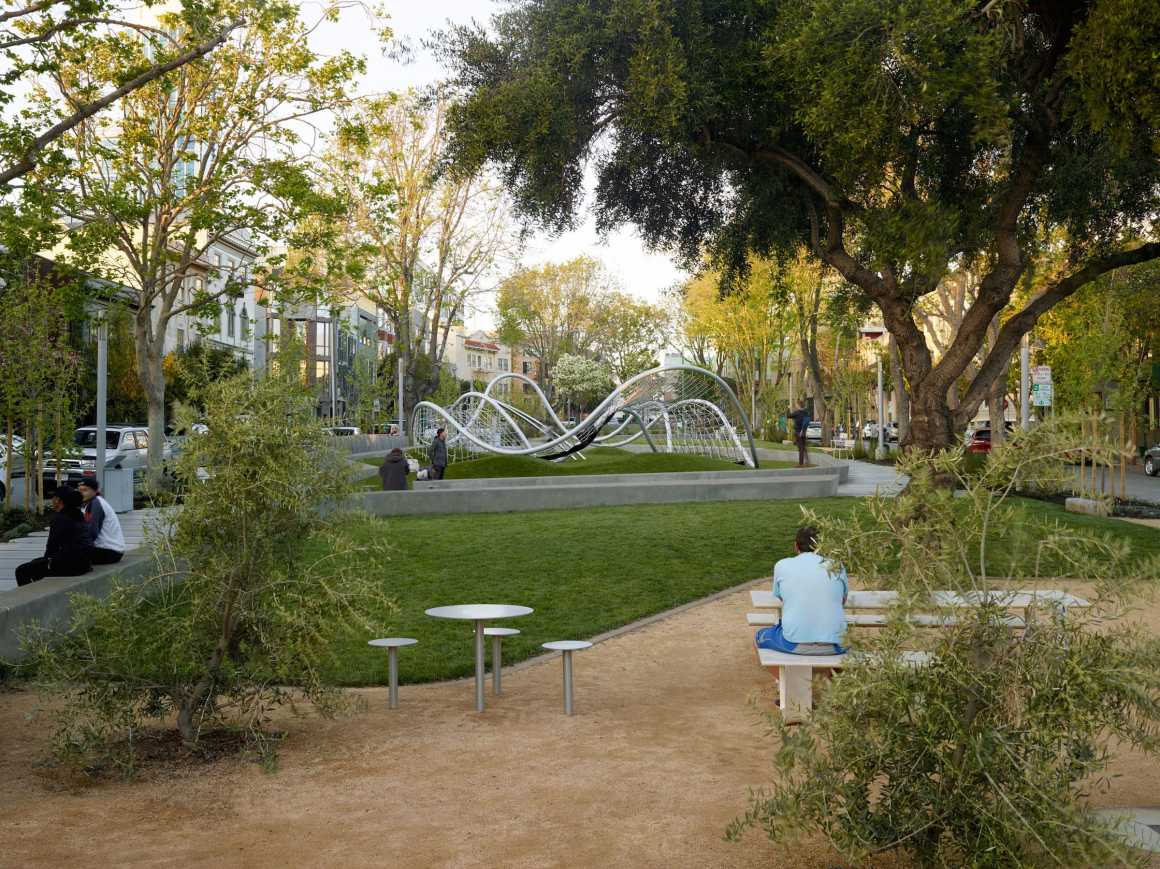
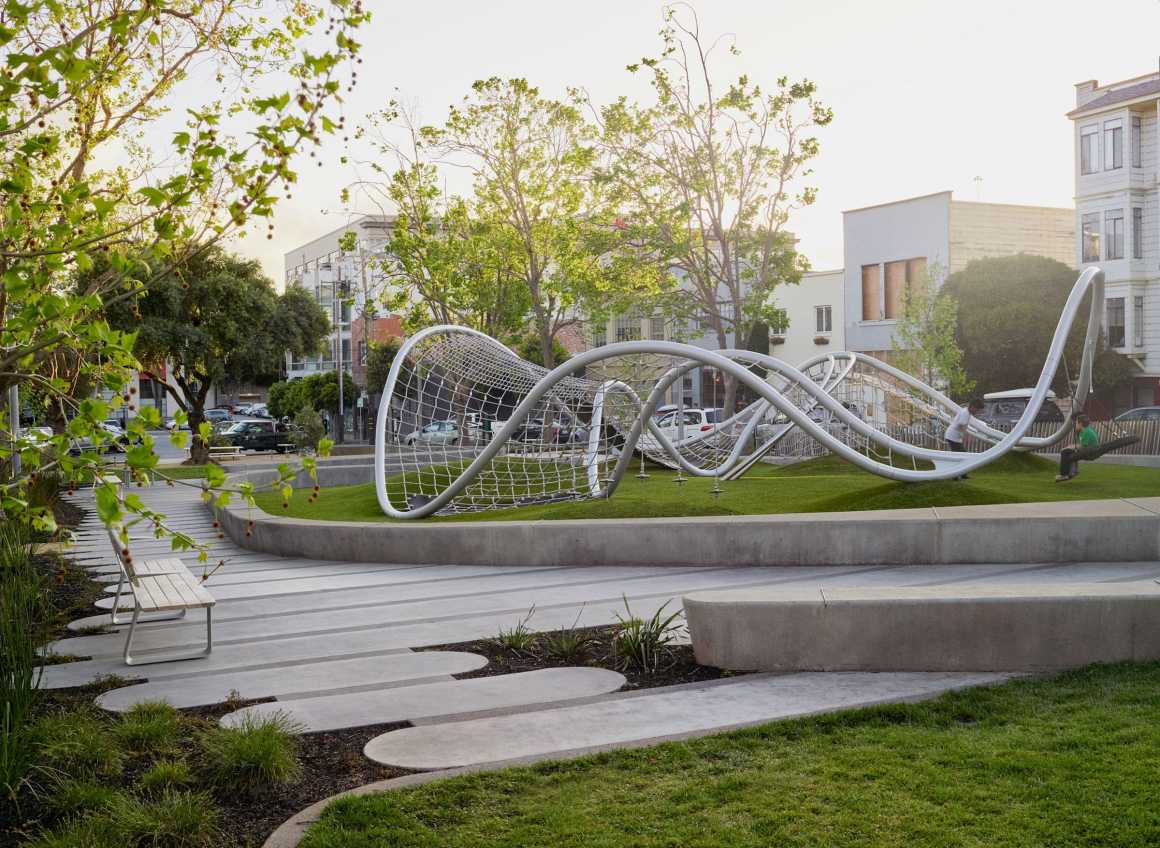
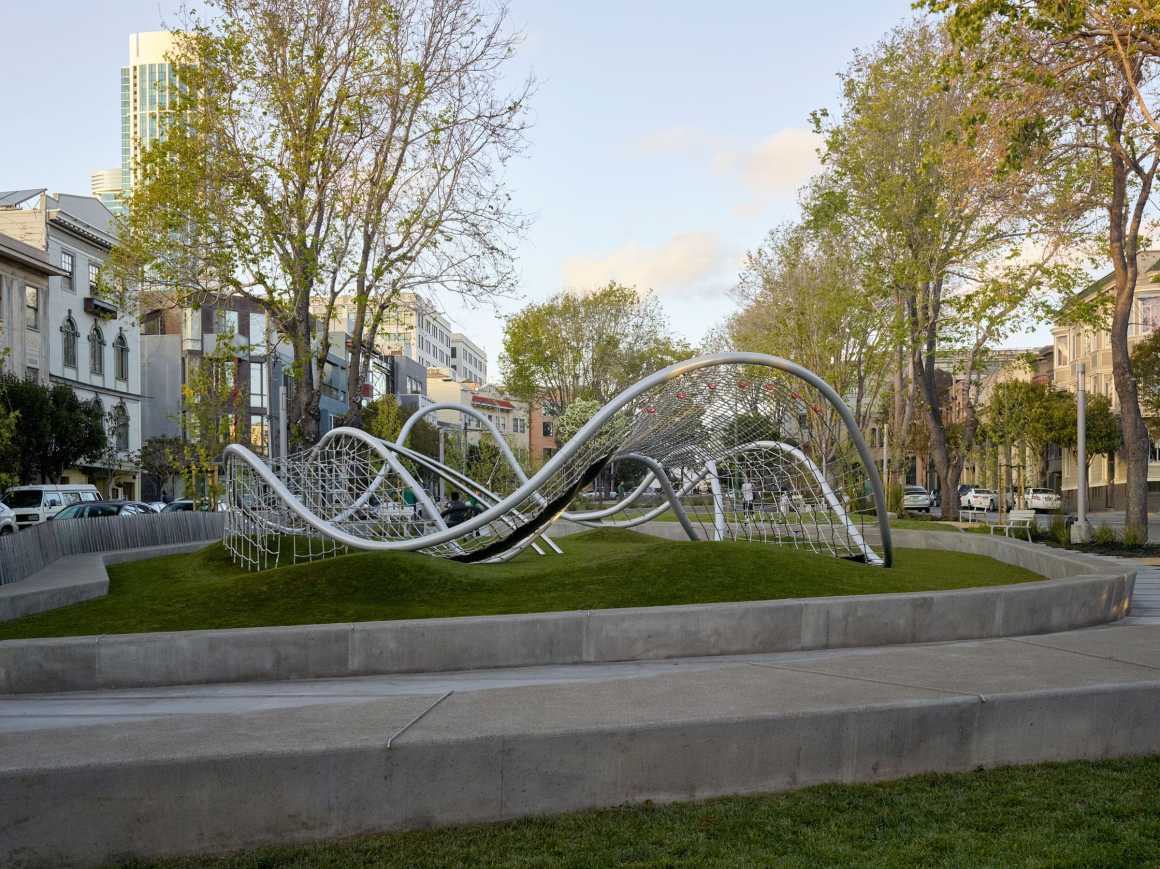
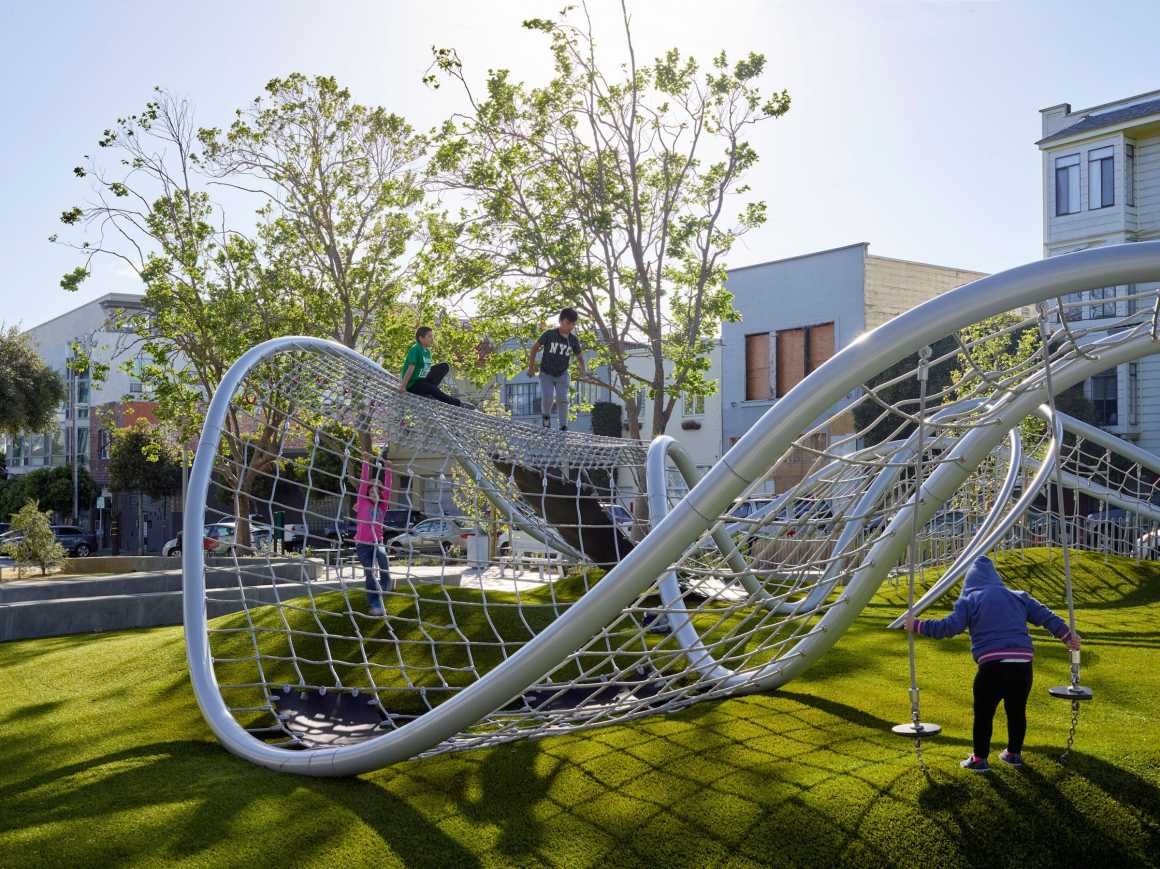
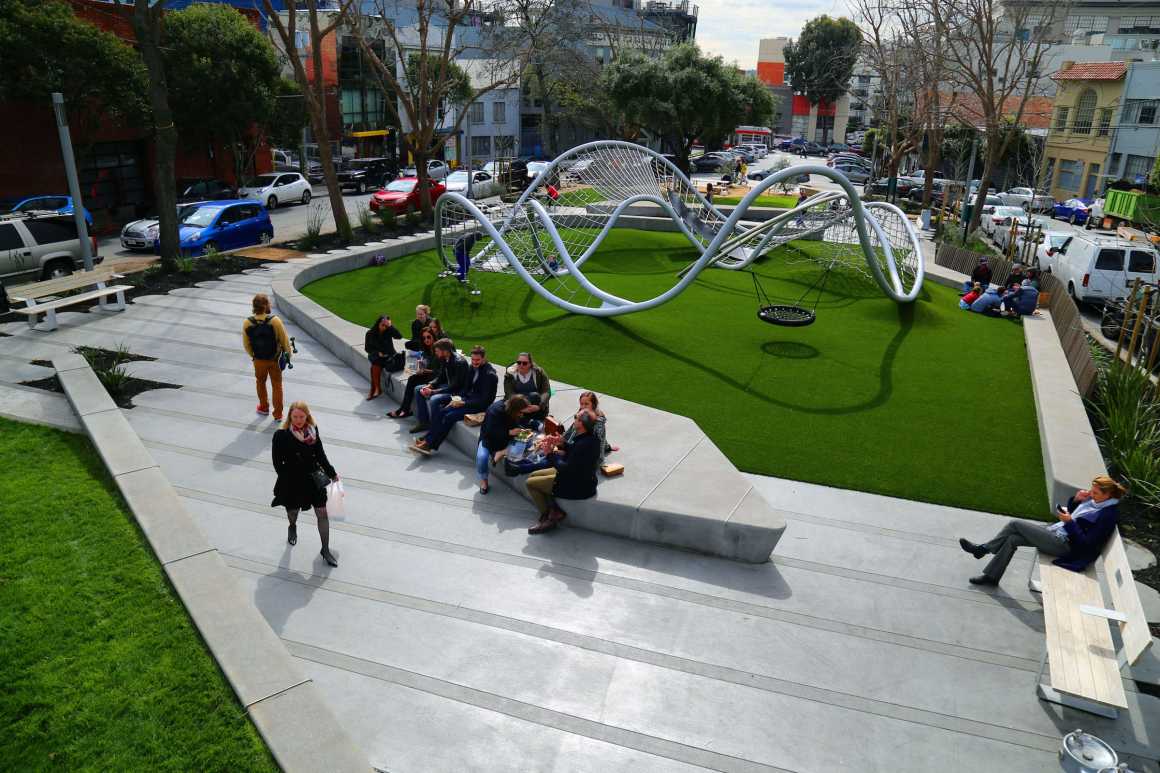

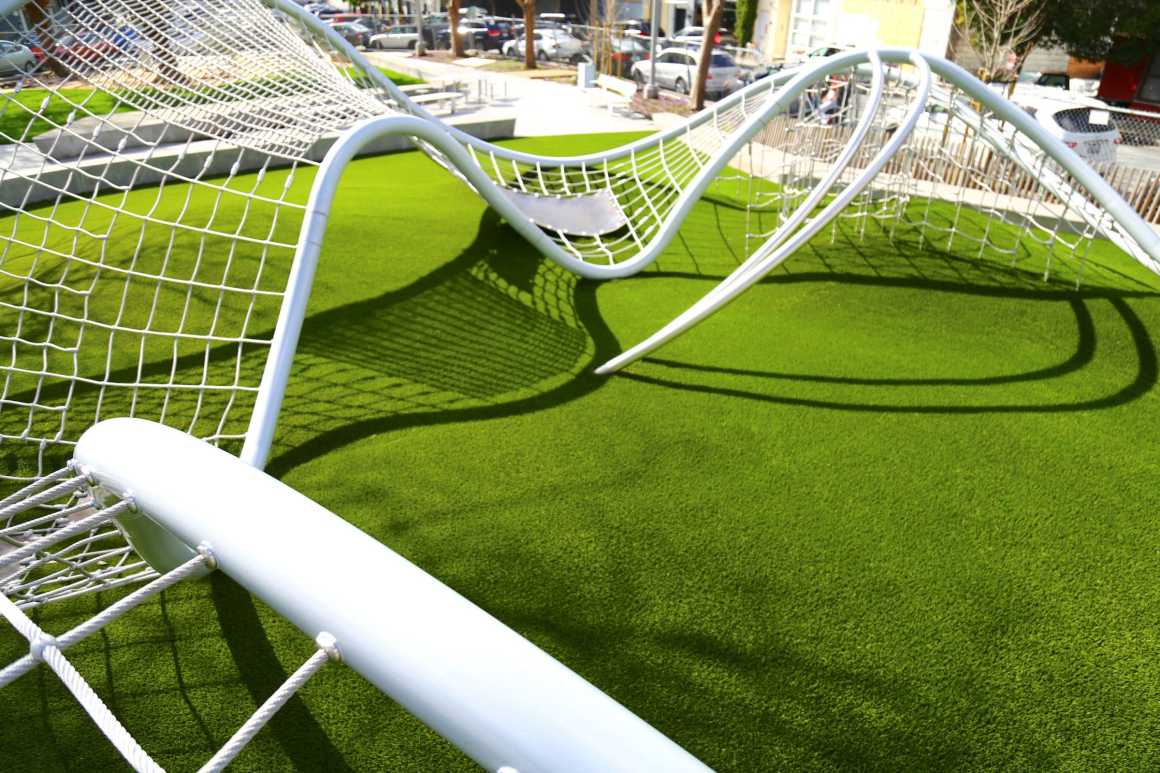

▼公园细节 Details

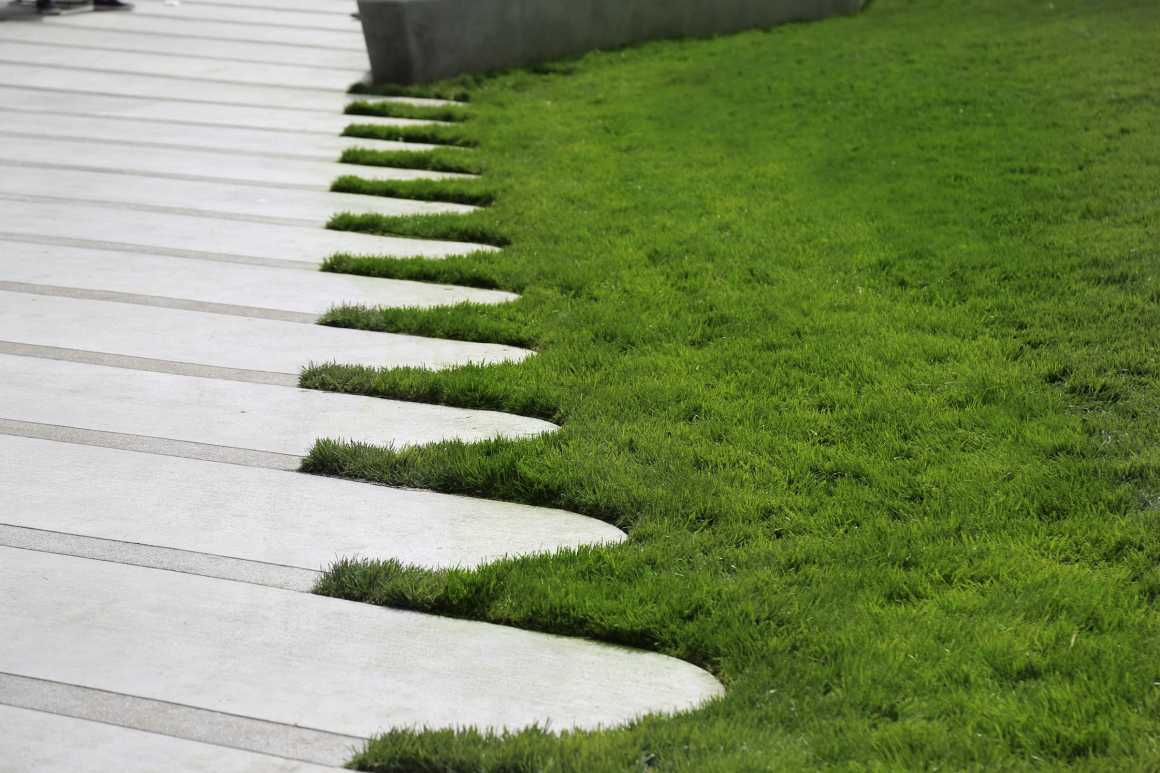
▼公园结构示意图 Structure of the park
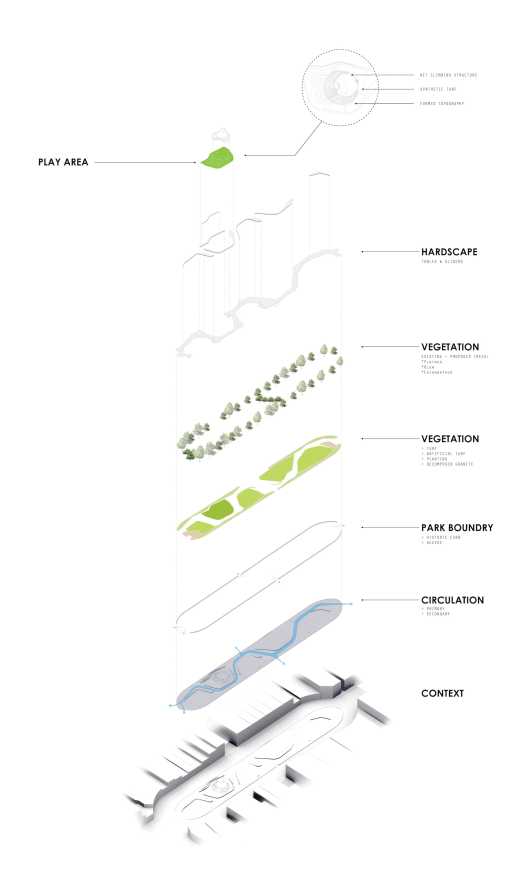
▼装置制造过程 Fabrication process of play structure

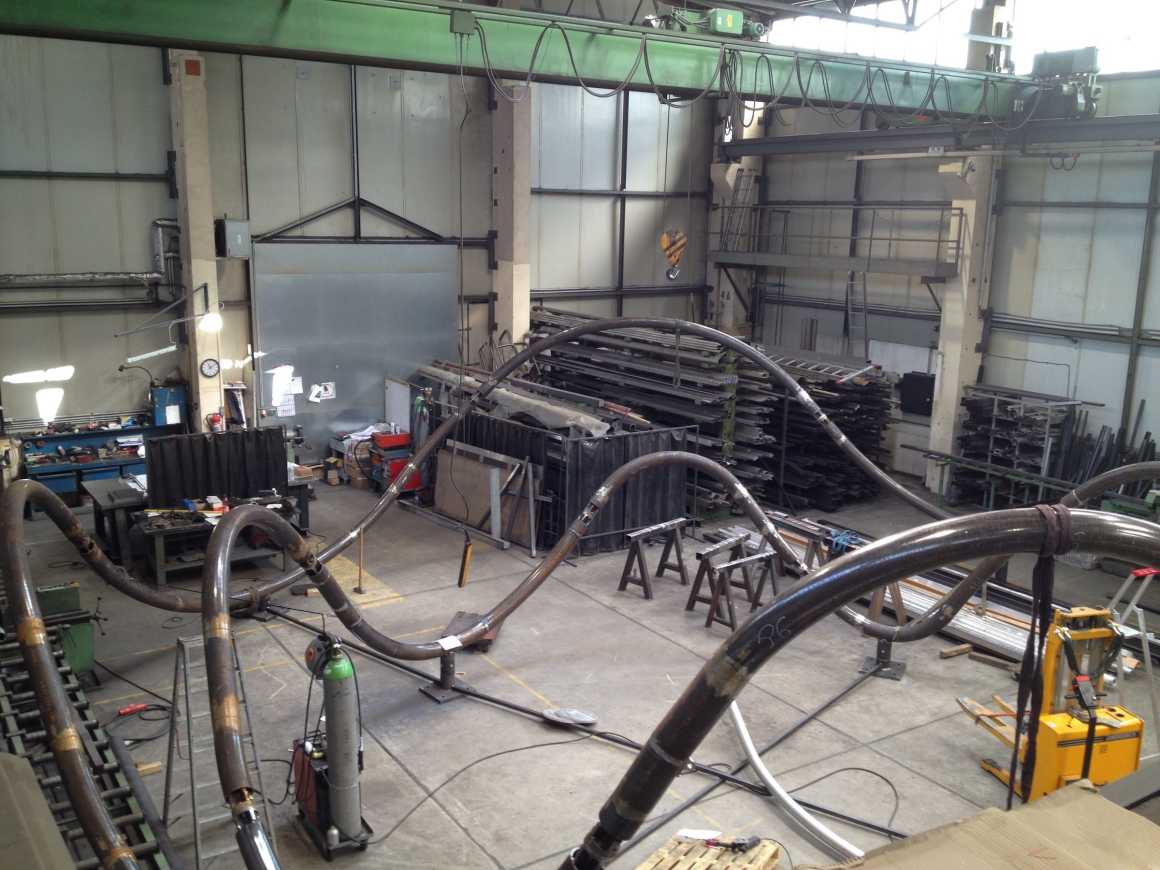
项目名称:南方公园
设计年份及竣工年份:2011-2017年
首席设计师和团队:David Fletcher, Cory Hallam
项目地点:旧金山SOMA
景观面积:4856.228平方米
图片版权:Marion Brenner, Fletcher Studio in-house
无人机拍摄:Luke Hegeman, Scott Peoul
客户:南方公园改善协会
项目使用的产品:柏林定制的游戏装置
Project name: South Park
Design year & Completion Year: 2011-2017
Leader designer & Team: David Fletcher, Cory Hallam
Project location: SOMA (South of Market), San Francisco
Landscape Area: 4856.228 sqm
Photo credits: Marion Brenner, Fletcher Studio in-house
Drone shots by: Luke Hegeman, Scott Peoul
Clients: The South Park Improvement Association
Brands / Products used in the project: play structure custom made by Berliner
更多 Read more about: Fletcher Studio




0 Comments